Getting There: Integration or Separate-But-Equal?
All of the wonderful, diverse comments in response to my interview with Eric Iwersen have brought up some points about bicycle-car interactions that merit further discussion. The conversation started to get interesting when it focused on the case study of the transformation of Apache with the light-rail construction. As Eric described, Apache went from a six-lane arterial signed at 40-45 mph to a four-lane arterial with a bike lane, on-street parking, 35 mph speed limits, and more extensive pedestrian access.
While overall I think the retrofit is an improvement (especially lowering the speed limit), it does raise a general question (legalities and design standards aside): does the presence of bike lanes fool drivers and bicycles into thinking that bicycles should only be found in bike lanes? And if that’s the case, do bike lanes thus mis-educate drivers and cyclists about how to safely and comfortably interact with each other, as suggested by Al, Freewheeler, and Ben?
If the answers to these questions are yes, what are some alternative methods that Tempe could employ? What’s working, and what could work better?
As Ben said, probably the biggest improvement to Apache from a bicyclist’s perspective is speed reduction: fatal accidents happen when vehicles travel at speeds over 30 mph, so slowing traffic down should have favorable consequences for accident rates and will make it easier for bicycles to ride with traffic. From what I understand of the City’s history, though, they have found it politically complicated to universally lower speed limits (drivers get grumpy about this). Instead, the City is working to phase in lower speed limits as other retrofits occur (Eric, please correct me if I’m wrong about this).
So, what else? How about sign changes? Here are three ideas with various merits and limitations:
1. Sharrows. Several other US cities have been testing out “sharrows,” signs painted on the roadway that indicate that cars should expect to share the roadway with bicycles, and indicate where cyclists should ride (i.e. free of the “door zone”). From my experience riding around in areas with sharrows, I don’t think they really do much for anybody, because they’re usually put in places where drivers already expect to see bicycles, and they’re only really useful in situations where lanes are already quite wide and allow vehicles and bicycles to share the same lane.
2. Share the Road. In Tempe we’ve already got a lot of “Share the Road” signs up, but I personally don’t think that they register with motorists because they aren’t white (legally required directions) or yellow (advisory). And also, what does it actually mean to share the road? Does that encourage bikers to ride too far to the right?
3. BAUFL-CLTP. After some heavy deliberation, San Francisco is implementing what they call BAUFL-CLTP signs in some areas(“Bicycles allowed use of full lane – change lanes to pass”): there’s a .pdf summary document about these signs here. Has the sign change been successful? I don’t really know yet–if you know more, let me know. I think these signs would shock Tempe-area motorists, though.
My question to you is, do you have other ideas or further insights into the ones presented here, or commentary on these possibilities? What can we continue to do to make the majority happy with our transportation infrastructure?
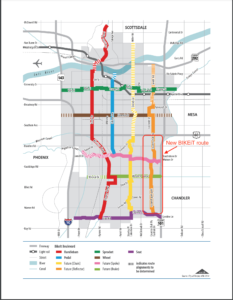
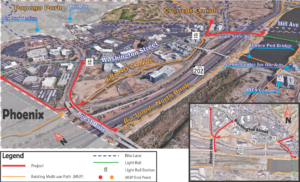
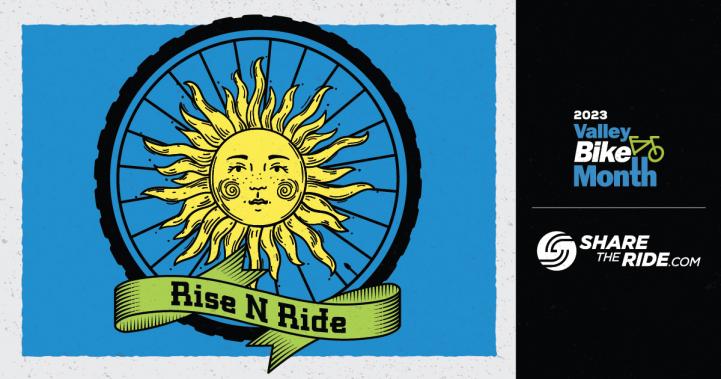
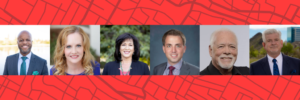
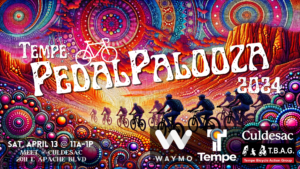
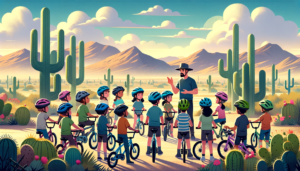
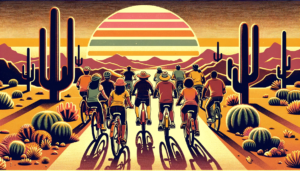

Well I am rather vocal because I cycle to get places, and recieve lots of road rage in doing so and want it to stop.
It is all perception of the motorist (even the educated ones), and I myself don’t understand why if something is a privilege why we stand by and do very little to change this preception. We don’t even provide a tax credit to cycle into work.
Get legal cyclists on the road instead of the sidewalk.
Replace the share the road signs with BAUFL-CLTP.
Cyclists need to how wide roads/shoulders are (bike lanes and WOL) information should be provided.
Add Sharrows when you end a bicycle lane if not near an intersection, or lanes merging or ending.
We need some laws. (3 foot law with fines and a way for cyclist to legally record the plate number etc submit a fine to the police).
We need some education in driving classes for cyclist and drivers. I am aware of the LAB courses for cyclist. Currently getting a DL or keeping points off your DL has no classroom instruction from what I am aware of.
Reduce the speed save lives, drivers already enjoy the fastest transportation method. Why do they need to go faster?
As I see it we need to do alot to change the preception that the auto is a destructive beast and not number 1.
For me bicycle lanes only create more problems than they solve considering you haven’t changed the perception of the motorist in the first place.
Alot of people I talked to don’t want cyclist on the road.
Arizona already has a three-foot law: ARS §28-735. And ARS §28-815 requires cyclists to take the lane when there isn’t enough room for a vehicle and bicycle to safely occupy the road side-by-side.
If you think through the implications of those laws, there are only two options: cyclists ride to the right when the lanes are at least 15′ (7′ SUV + 3′ passing + 3′ cyclist + 1′ shy distance each side, and those figures are extremely conservative), or cyclists take the entire lane.
As far as I’m concerned, the overwhelming majority of roads and signage (especially the “Share the Road” bullshit on 10′ lanes) are simply illegal. When the lanes are marked in such a way that they require and encourage drivers and cyclists to violate state law…what other term is there?
What makes matters even worse is when the bike lanes are themselves marked to require cyclists to ride through extreme hazards (such as the on-street parking right in front of City Hall or the storm drain / raised curb / choke point triple-threat “traffic calming” further west on 5th). Or, when bike lanes abruptly vanish or gradually dwindle from almost-wide-enough to mere inches. The terms that spring to mind are “willfully negligent” and “malice aforethought” and “simply homicidal.”
The city has only two realistic choices: fix the lane markings (which will often require eliminating vehicle lanes and / or widening the road), or lower the speed limit and replace Share the Road signs with BAUFL-CLTP. Or, of course, the city could wait for somebody to get killed while both the driver and the cyclist were following the city’s signage and lane markings, and get sued into oblivion — but I really don’t think anybody wants that.
Cheers,
b&
The white on green Arizona share the road sign is a disgrace. It shows a cyclist hugging the curb with a motorist passing closer than 3′ (if assumed to be to scale)
Much better is the BAUFL0-CLTP, but that can be too much information as well. Simply a yellow diamond that has a cyclist icon and a “Share the Road” text below is good – it doesn’t show, describe or imply a specific cyclist lane position – so this sing works for narrow as well as wide lanes.
Al
perception is a funny thing…
safety is a huge issue for peds and cycles in the PHX metro. frankly, it is not very safe to NOT be in a vehicle in the valley. most drivers are angry due to quasi-long commutes etc. what people in vehicles do not realize is that miles vs time is amazingly efficient in the valley. when living in PDX i rode my bike everywhere, as i try to do here. the main reason being that it took 15-30 minutes to drive 5 miles or less. it was actually quicker to bike! here in PHX, anyone can drive 10 + miles in 15 – 30 minutes. not a good incentive to bike i suppose unless you are enthusiastic about it. there is no reason to have road rage in an area that is so vehicle oriented. maybe if some people knew how long it really takes people in other parts of the country to get places they would relax behind the wheel? maybe not. just my 2 cents i suppose.
Getting There: Integration or Separate-But-Equal?
@Op
let me use a quote.
“Vehicle miles totaled about 1.1 trillion in 1970, rising to more than 3 trillion miles in 2006, according to the highway agency. That’s a 172 percent increase.”
How about an H class vehicle DL? Which would be voluntary to obtain.
Then apply the DL to certian laws serpate from other classes. This would favor bicycles as you could have vehicle demensions and applications/limitations to apply to the H class laws. IE Splitting the lane.
H stands for Human Powered
@BG
Did you read the law or just spit it out?
“3 foot law with fines and a way for cyclist to legally record the plate number etc submit a fine to the police”
I don’t want to be dead or dying in order to produce just a fine. They tried to change the law but failed to pass it up.
@Benny
The reason for that is because they passed the .5 cent sales tax on us in the 80s . Then spent 1.3 billion dolars on light rail (20 years to fund the project).
Of course they built the 202 ,101, 303 portions, 51, out of all this funding from the 80s. Take a drive to Tucson very few if only one freeway (more bicyclists).
For the billions of dollars, we got more driving see above quote^
We currently for the last several years can’t meet EPA air quality standards for the entrie Maricopa County.
@ myself
note to self move out of this crap and move to some other crap in another country.
@ AL
Keep up the good work, watch out for the rigth turn on CC & 60
@Rebbecca
Still going to the Library? Good luck?
ben: Good points, altogether. I recently came across an article about enforcement of the 3-foot law in Utah over at Cicle (look through their news section). It doesn’t appear to require death for enforcement, though it’s still a bit tricky to enforce.
If we want to see such changes made to the transportation infrastructure in a place like Tempe, moving away doesn’t seem like the best way to address the problem. Then there’s just one fewer bicycle and drivers will see even fewer of us and life becomes that much more car-oriented for those left behind.
It also seems to me that you’re implying that legal action is in order to deal with some of these concerns (I hadn’t considered that the Share the Lane signs might actually be illegal), but perhaps you’re right. At the same time, in Tempe at least the City officials seem pretty sympathetic to the concerns of cyclists, even if they aren’t always sure of how to deal with those concerns and don’t always get everything perfect all at once.
And yes, I’m still going to the Library, and it’s still obnoxious to ride on the sidewalk to get there. 🙂 I hope that if I’m still whiny enough about that particular BBT someone will do something about it. I almost rode home on the road on Southern, but then got intimidated by the fast traffic and the fact that I’m not as brightly lit as I’d like for night-riding among cars going 45 mph.
I agree that riding on roads like Southern (especially at night) can be intimidating at first. I didn’t ride on Southern when I first got into cycling, but built up experience on other streets.
For example Rural south of Bel de Mar (at the canal) has moderately wide outside lanes. This is good place to learn your visibility and driver reactions to you before riding in narrow outside lanes. With a rear view mirror you can see motorists approach and react to you presence. If you ride near the center of the lane 9/10 drivers, actually more, will move into the next lane over well before they get to you if you have good visibility at night. The other few will slow down and move as they are a bit closer and if it is otherwise safe to do so you can move right to let them pass. Since the lane is wide you feel more comfortable as you have that ‘escape’ space to move into in the right side of the lane (which I have never had to use, I only move there for courtesy to other drivers).
Then you take that experience to roads like Southern and you see the same patterns in the rear view mirror, drivers merging left before they get to you. I do get honks once in a while, but a honking driver is a driver who sees you – so it should make you smile.
I personally don’t care one way or the other about the 3′ passing law. Far more important to improved safety is speed limit enforcement and also dealing with the status quo problem that that 11mph over the speed limit is acceptable to law enforcement.
Al
“And yes, I’m still going to the Library,”
That is good to hear, happy driving!
Al is right “experience on other streets.”
I wear an ANSI 2 reflective vest and people can see me 500 feet away at any time of the day.
“9/10 drivers” that is an accurate estimate yet remember more cars pass you if you’re the slower type. I can use my mirror for the 10th person (hear them too).
Guadalupe, Warner, and Kyrene with bike lanes and are 45 mph I do believe. Merging left at intersections will build up the experience. (time the intersection so you have a red light, and then wait in line)
I agree 11 mph is way to much speed considering the auto is suppose to work why do you need 11mph over on your speedometer.
“Then there’s just one fewer bicycle and drivers will see even fewer of us and life becomes that much more car-oriented for those left behind.”
True, but I had to move here in the first place, and why limit my cycling environments. Don’t worry cycling is only getting better!
This is my preferred Share The Road sign as it shows car and bicycle sharing same line of travel:
http://www.bikexprt.com/massfacil/nonstandard/images/Share600sm.gif
This one is the standard and is very good as well as it does not show or imply relative position of motor vehicle and bicycle:
http://www.trafficsign.us/650/warn/w11-1share.gif
The current Arizona white on green showing a cyclist in the gutter getting close passed has got to go. It sends the entirely wrong message to both motorists and cyclists as to what share means.
Al